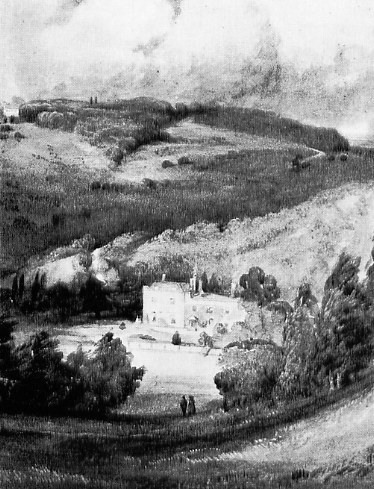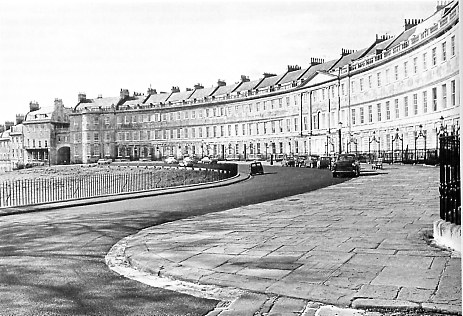
This essay first appeared in the Burney Letter, Vol 6 No 1 (Spring 2000), pp. 1&6
by Ellen Moody

"I must crave indulgence. We country girls, however noble, have always led retired lives in remote castles and convents. Apart from religious ceremonies, triduums, novenas, gardening, harvesting, vintaging, whippings, slavery, incest, fires, hangings, invasion, sacking, rape and pestilence, we have had no experience. What can a poor nun know of the world?" (Italo Calvino The Nonexistent Knight, 1959
During a conversation a few members of Kevin Berland's C18-l had in which we offered to the list's consideration some candidates as one of the most significant eighteenth-century woman writers of the second millenium, my choice of Frances Burney d'Arblay drew surprise and discomfort. Unlike Aphra Behn, Mary Wollstonecraft and Charlotte Corday (other choices), Fanny's life was not atypical; her words, not aggressively subversive of hierarchy, patronage and gender as ways of determining which individuals in society should have power over others. Granted. In her work and life Fanny Burney dramatizes the kinds of courage publicly unrewarded conquests and unspoken achievements demand. All the more are her acts and words among the most meaningful we have on record for women. She presents herself experiencing the obstacles, losses and half-insane behavior many women confront, and she writes about these in a moment by moment way for nearly forty years as difficulties not in least minimized but only with intense conflict overcome and sometimes not even then.
Fanny is us. She compares with the French chameleon-diplomat, her almost exact contemporary, Charles-Maurice Talleyrand-Périgord (1754-1838) whose path she crosses at turning points in her life, and whose "made up countenance" she recognizes.1 Like him, she is always there, in the background, wearing a fancy hat. Like him, she passes through the chessboard of their world obliquely. She is a daughter, a sister, a friend to the great, a courtier. She makes the thoroughly acceptable splash (Evelina), is lionized and pressured to do it again. She produces serious text, her novel, Cecilia, which continues to define her to the end of her life. Her enactment of the role of confined underling whose task it is to keep the queen's robes (really to arrange her hair each morning) is too great a strain on her need to fulfill passions within herself, and she escapes to marry a refugee from a revolution (who, imitating her, recedes into her background as "the husband of Cecilia"). They retire to a cottage they improve but never manage to own and eventually lose. Again, like Talleyrand, she is always noticed as a felt presence. Her contemporaries did not forget her once they read her books, met or heard about her. It will be said that it is we who read an awareness of Fanny into others her life touched: since the publication of her vast corpus of diaries and letters we have imagined the period as she "Theatricalised" it.2 If you want to get behind the reticence of most pre-twentieth century writing about sexual experience and what behaviors skirt embarrassment in public, you read Boswell. If you want vivid records of early phases of consumer life in England and France, great cities and small; of private theatricals, riot, fire and flight; of a mad yet discerning king; of how it feels to live at court or in a city near which armies are massing just before, during, and after battle; of travelling as an unarmed, powerless individual through a countryside crowded with soldiers and officials fighting both a civil and foreign war to reach a disabled aging soldier-husband, you read Burney. Fanny's gifts include an ability to recognize the universal in the salient in epitomizing dramatic scenes. She left us a vast slew of non-fictional texts whose excitement derives from her drive to dramatize how the public world impinges on, pressures, frustrates and controls her -- and anyone who has been in her position.
Nonetheless, she doesn't draw our or her contemporaries' attention simply because she experiences life from the angle of the ordinary vulnerable individual. When she refuses to marry someone who doesn't attract her, when she suffers because she cannot extract consideration from a dense bully, when she has to work hard to insist that her papers are validly stamped and has to name some connection (in her case the noun-password was "General Kleist von Nollendorf"), so as to move on to some other point in a map, she brings into play in literature for the first time a self-conscious determined desire to stop the public world of authorities and officialdom from thwarting the needs of her private self. Fanny Burney is the first woman writer to delve into the private world of a woman's inmost spirit as it emerges in public and communes with itself in continuous diaries and letters she left to be published.3 Her brave record of her endurance of a mastectomy without anaesthesia, at the top of which she wrote "Respect this and beware not to injure it!!!" is simply the most striking instance of her attempts to break the barriers of what cannot be said or written down, to tell the full truth about her existence, confess, as she wrote in the first page of her extant diary, "my every thought." She understood if she didn't look at reality unsparingly, she could not begin to understand why she made the choices she did.4
F.B.d'A thought sceptically and acted independently and unconventionally. The building blocks, the literal paragraphs of moral and psychological analysis and dramatic narrative which comprize The Witlings, Cecilia, Camilla and The Wanderer are thick-strewn with subtle analyses of the amoral hypocrisies and private cant that are still part of our lives.5 Hemlow points out how Fanny did not marry for money or position; Margaret Anne Doody surveys Madame d'Arblay's intangible life with her husband, to conclude: "She waited a long while, but when she married, she did it well."6 I think it important that Fanny chose to have one child. It means she had to deal with the reality of a helpless infant, its long years of dependent childhood, and spent much of her time trying to help him become an adult and find or create a niche in the world for himself too -- while writing on in her diaries and plays to express herself and in her novels to support herself and her husband. It also means she and her husband agreed on some form of contraception, the one indisputable liberation from nature and custom many women have known for the first time in the twentieth century. To paraphrase Hemlow, the utility of a conventional public mask was something Fanny exploited.
An oddity on the blue plaque which decorates the building that was once Juniper Hall (and
today houses a Field Studies Council) is suggestive. The famous people who dwelt there "in
1792" are simply named: Madame de Staël, the Comte de Narbonne, and of course Talleyrand.
Only Fanny's name is accompanied by a trail of later circumstance, the kind of corroborative
detail many of us use to remember an event that counts to us: "Fanny Burney, the novelist, as a
visitor to her sister, Susanna Phillips of Mickleham met Alexandre d'Arblay to whom she was
subsequently married at Mickleham Church."7 Perhaps people quarrel over how to name Frances Burney
d'Arblay because we identify so strongly with her as Everywoman
so that how she is named can make visible a painful contrast between how others see us and how we want to be seen.
1. cited in Kate Chisholm, Fanny Burney: Her Life,. 1752-1840. (London: Vintage, 1999), 253.
2. The Early Journals and Diaries of Fanny Burney, ed. Lars E. Troide and Stewart J. Cooke, vol 3 (Montreal and Kingston: MCgill-Queen's University Press, 1994), 146.
3. Only towards the end of the eighteenth century did a sense of individual indentity, apart from a narrow family or close network of friends and neighbours, begin to emerge. It is only then that ordinary people could write letters and mail them to a single recipient, confident that they were unlikely to be opened by government officials (or perhaps by the curious or greedy) as they made their way across the landscape. Only then could one hope that if labelled private, a letter would not be regarded as the property of the whole family and read as by right by the most powerful member of it.
4. Cited in Chisholm, 313, n. 39.
5. Early Journals and Letters, ed. Troide, 1: 1-2.
6. See the intelligent, persuasive, and eloquent Margaret Anne Doody, Francis Burney: The Life in the Works. (New Brunswick, New Jersey: Rutgers University Press, 1988). 77-91, 111-149, 205-73, 318-68.
7. Joyce Hemlow, The History of Fanny Burney (Oxford: Clarendon Press, 1958), 241; Doody, 203.
8. The plaque is described in Chisholm, 308-9, n. 11.
